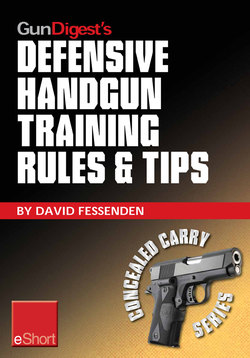Читать книгу Gun Digest's Defensive Handgun Training Rules and Tips eShort - David Fessenden - Страница 3
ОглавлениеI have always wondered where I was going to put all the witticisms, sayings and related pearls of wisdom that abound in our field of firearms and firearms training. These are the thoughts and words that just don’t fit anywhere else or do not lend themselves to the length of a full chapter. I suppose this is as good a place as any.
Tactical Training and Dry Practice
In order to establish a training regimen for dry practice, live fire and perhaps even concealed carry, you will need to research and decide the type of firearm you will train with and ultimately carry.
Pick only one weapon to train with. It will ultimately become your carry weapon, should you decide that your journey will end there. It can be either a pistol (autoloader) or a revolver.
Here are the variables you must consider when choosing a weapon. A few of them are widely agreed on (for example, .the .380 ACP or .38 Special cartridge is generally considere to be the smallest that can be relied on for self defense), while others are purely a matter of personal preference.
Bullet caliber
Size of the weapon
Model of the weapon
Weight of the weapon
Firepower (capacity)
Barrel length
Action (double or single)
Anatomy (hand size and the shooter’s strength)
Stock size (configuration of stock to hand size)
Dry Practice
Live fire will serve to validate your progress with your dry practice training. It is not intended to provide the student with any form of fun or entertainment.
Your goal for your marksmanship drills is to develop the ability to deliver two sighted shots to the thoracic cavity of your target at 7 meters in 1.5 seconds with about 95% consistency. Ideally, these shots should print about two inches apart. This should ensure your survival in a gun fight.
The head shot will virtually guarantee your survival. It is a precision, sighted shot and needs to require about two to three seconds to achieve.
Tactical Training
There are three types of shooting disciplines:
Recreational Shooting
Helps the student understands the basic fundamentals of firearms nomenclature and simple marksmanship.
Bullseye and Competition Shooting
Includes all of the above benefits and adds the discipline of execution. It further adds stress via time constraints around slow and rapid fire at a fixed target. Bullseye shooters must present their weapons from the holster rapidly, solve complex range problems and get quality hits with precision. Long distance bullseye competition is not a consideration here.
Tactical Shooting
Its demands include all of the above, but it includes the principles of tactics (movement) and the psychology of a combat mindset combined with an emphasis on survival. Time constraints can also be added, if desired.
Gun Fighting
Gun fighting, as most of us know it, is what we see in the movies or on the television. We can all put some stock in the knowledge that most of it is the figment of some Hollywood writer’s imagination. However, in our heart of hearts, we know that from historical evidence, a certain percentage of that sort of sudden violence did happen.
So, indulging our fantasies, gun fighting requires a combination of precision (accuracy) and speed to insure survival. Of the two ingredients, precision is the most important.
Some random quotations that have survived the test of time are included below. The authors of these quotations are not known, but I will still put quotes around them, in deference to those responsible for their creation.
I have reason to suspect that the latter quotation can be attributed to none other than Col. Jeff Cooper.
There is no way to totally prepare for that dreaded gun fight unless you adhere to a regular dry practice routine. That will help, because the variables you will face are myriad. As is true for any athlete, training is the answer to increase your survival chances. Practicing all the combat scenarios you can imagine is the secret here. Practice them all until they become totally reflexive in nature. You need to be on autopilot while doing them.
Here are some of the conditions you will encounter in a typical gun fight environment:
Chaos
Noise
Close Distances
Confusion
Fear, stress and anxiety
Very short duration (5-10 seconds to a couple of minutes)
Movement seemingly in slow motion, referred to as tachypsychia
Tunnel vision
Your responses here should be:
